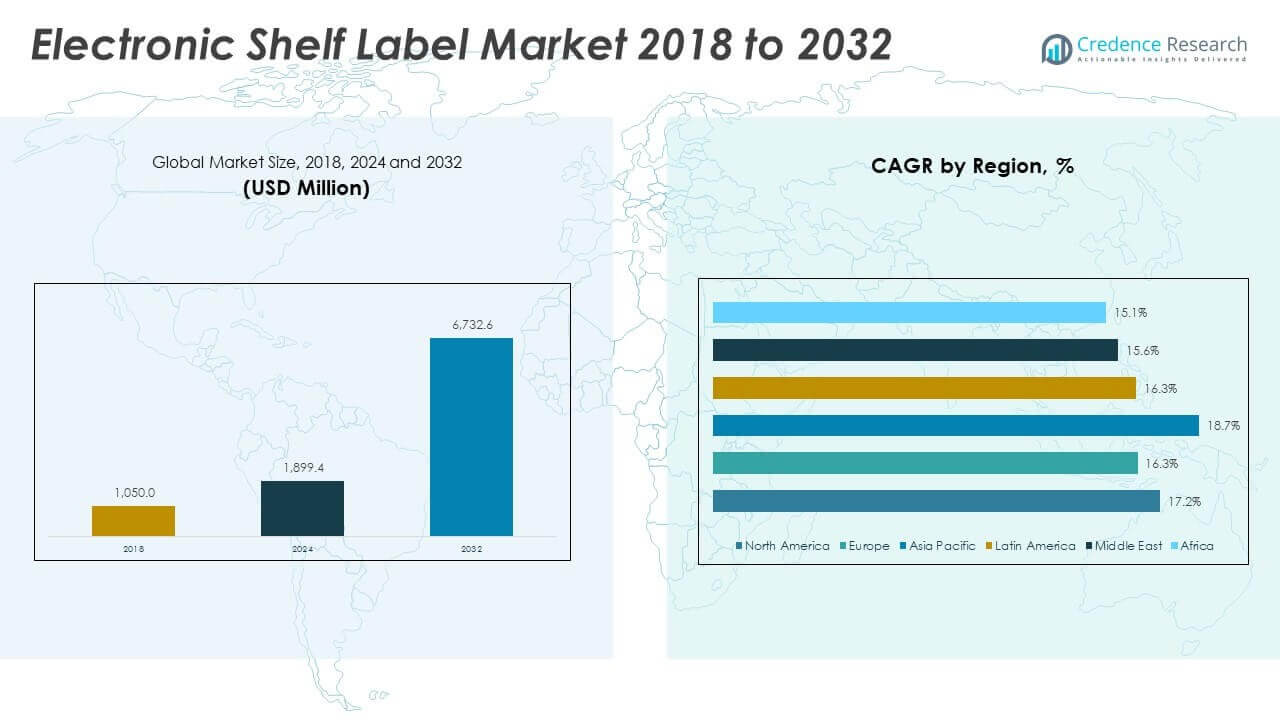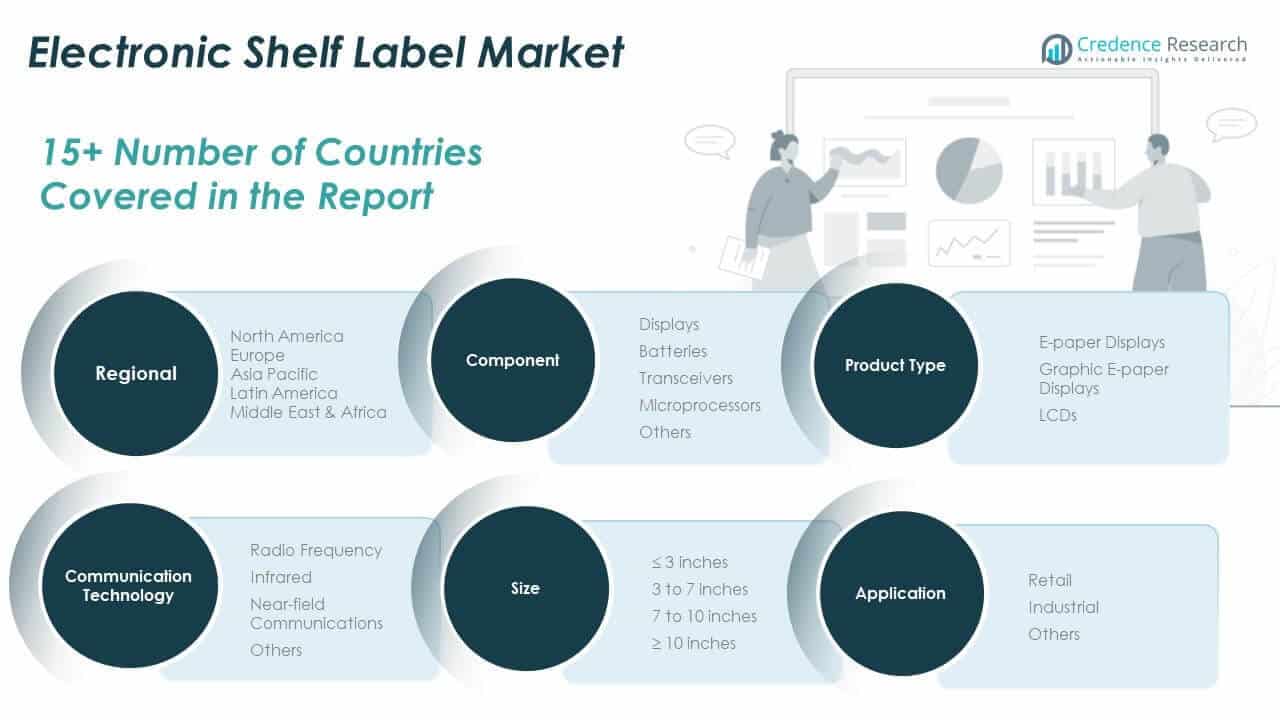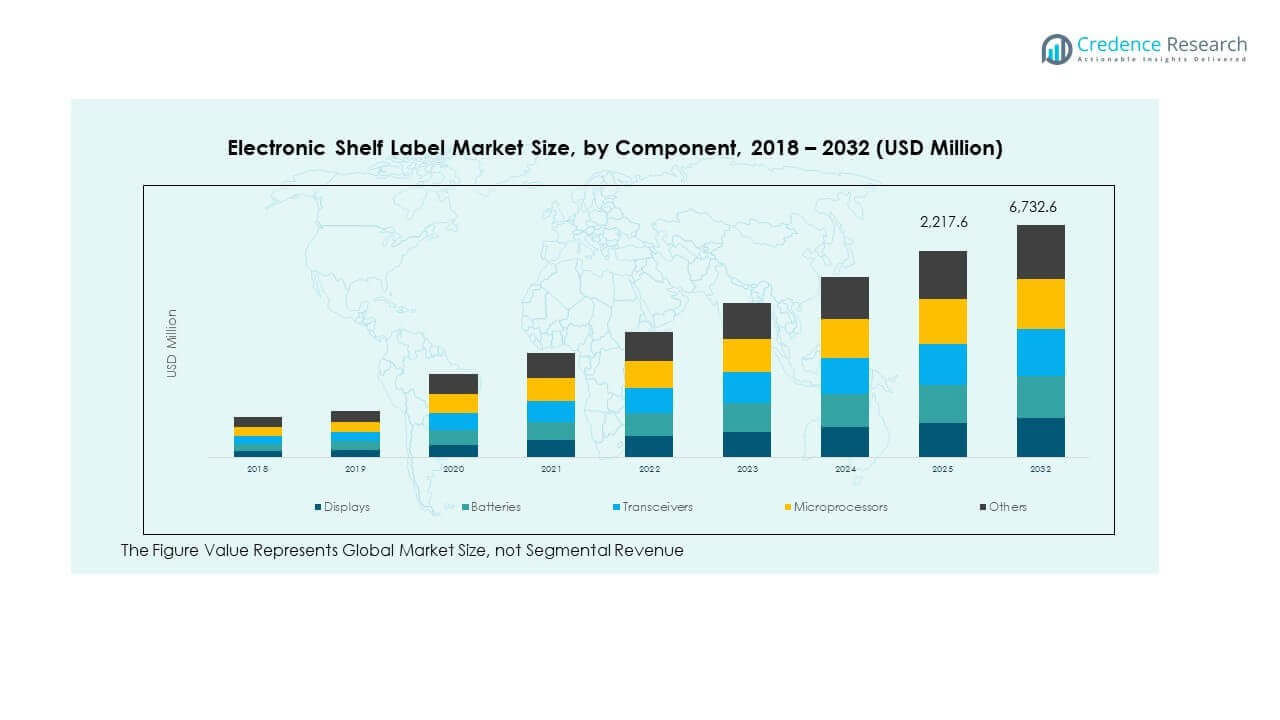CHAPTER NO. 1 : GENESIS OF THE MARKET
1.1 Market Prelude – Introduction & Scope
1.2 The Big Picture – Objectives & Vision
1.3 Strategic Edge – Unique Value Proposition
1.4 Stakeholder Compass – Key Beneficiaries
CHAPTER NO. 2 : EXECUTIVE LENS
2.1 Pulse of the Industry – Market Snapshot
2.2 Growth Arc – Revenue Projections (USD Million)
2.3. Premium Insights – Based on Primary Interviews
CHAPTER NO. 3 : ELECTRONIC SHELF LABEL MARKET FORCES & INDUSTRY PULSE
3.1 Foundations of Change – Market Overview
3.2 Catalysts of Expansion – Key Market Drivers
3.2.1 Momentum Boosters – Growth Triggers
3.2.2 Innovation Fuel – Disruptive Technologies
3.3 Headwinds & Crosswinds – Market Restraints
3.3.1 Regulatory Tides – Compliance Challenges
3.3.2 Economic Frictions – Inflationary Pressures
3.4 Untapped Horizons – Growth Potential & Opportunities
3.5 Strategic Navigation – Industry Frameworks
3.5.1 Market Equilibrium – Porter’s Five Forces
3.5.2 Ecosystem Dynamics – Value Chain Analysis
3.5.3 Macro Forces – PESTEL Breakdown
3.6 Price Trend Analysis
3.6.1 Regional Price Trend
3.6.2 Price Trend by product
CHAPTER NO. 4 : KEY INVESTMENT EPICENTER
4.1 Regional Goldmines – High-Growth Geographies
4.2 Product Frontiers – Lucrative Product Categories
4.3 Component Sweet Spots – Emerging Demand Segments
CHAPTER NO. 5: REVENUE TRAJECTORY & WEALTH MAPPING
5.1 Momentum Metrics – Forecast & Growth Curves
5.2 Regional Revenue Footprint – Market Share Insights
5.3 Segmental Wealth Flow – Product Type & Component Revenue
CHAPTER NO. 6 : TRADE & COMMERCE ANALYSIS
6.1. Import Analysis by Region
6.1.1. Global Electronic Shelf Label Market Import Revenue By Region
6.2. Export Analysis by Region
6.2.1. Global Electronic Shelf Label Market Export Revenue By Region
CHAPTER NO. 7 : COMPETITION ANALYSIS
7.1. Company Market Share Analysis
7.1.1. Global Electronic Shelf Label Market: Company Market Share
7.2. Global Electronic Shelf Label Market Company Revenue Market Share
7.3. Strategic Developments
7.3.1. Acquisitions & Mergers
7.3.2. New Product Launch
7.3.3. Regional Expansion
7.4. Competitive Dashboard
7.5. Company Assessment Metrics, 2024
CHAPTER NO. 8 : ELECTRONIC SHELF LABEL MARKET – BY PRODUCT TYPE SEGMENT ANALYSIS
8.1. Electronic Shelf Label Market Overview by Product Type Segment
8.1.1. Electronic Shelf Label Market Revenue Share By Product Type
8.2. E-paper Displays
8.3. Graphic E-paper Displays
8.4. LCDs
CHAPTER NO. 9 : ELECTRONIC SHELF LABEL MARKET – BY COMPONENT SEGMENT ANALYSIS
9.1. Electronic Shelf Label Market Overview by Component Segment
9.1.1. Electronic Shelf Label Market Revenue Share By Component
9.2. Displays
9.3. Batteries
9.4. Transceivers
9.5. Microprocessors
9.6. Others
CHAPTER NO. 10 : ELECTRONIC SHELF LABEL MARKET – BY COMMUNICATION TECHNOLOGY SEGMENT ANALYSIS
10.1. Electronic Shelf Label Market Overview by Communication Technology Segment
10.1.1. Electronic Shelf Label Market Revenue Share By Communication Technology
10.2. Radio Frequency
10.3. Infrared
10.4. Near-field Communications
10.5. Others
CHAPTER NO. 11 : ELECTRONIC SHELF LABEL MARKET – BY SIZE SEGMENT ANALYSIS
11.1. Electronic Shelf Label Market Overview by Size Segment
11.1.1. Electronic Shelf Label Market Revenue Share By Size
11.2. ≤ 3 inches
11.3. 3 to 7 inches
11.4. 7 to 10 inches
11.5. ≥ 10 inches
CHAPTER NO. 12 : ELECTRONIC SHELF LABEL MARKET – BY APPLICATION SEGMENT ANALYSIS
12.1. Electronic Shelf Label Market Overview by Application Segment
12.1.1. Electronic Shelf Label Market Revenue Share By Application
12.2. Retail
12.3. Industrial
12.4. Others
CHAPTER NO. 13 : ELECTRONIC SHELF LABEL MARKET – REGIONAL ANALYSIS
13.1. Electronic Shelf Label Market Overview by Region Segment
13.1.1. Global Electronic Shelf Label Market Revenue Share By Region
13.1.2. Regions
13.1.3. Global Electronic Shelf Label Market Revenue By Region
13.1.4. Product Type
13.1.5. Global Electronic Shelf Label Market Revenue By Product Type
13.1.6. Component
13.1.7. Global Electronic Shelf Label Market Revenue By Component
13.1.8. Communication Technology
13.1.9. Global Electronic Shelf Label Market Revenue By Communication Technology
13.1.10. Size
13.1.12. Global Electronic Shelf Label Market Revenue By Size
13.1.13. Application
13.1.14. Global Electronic Shelf Label Market Revenue By Application
CHAPTER NO. 14 : NORTH AMERICA ELECTRONIC SHELF LABEL MARKET – COUNTRY ANALYSIS
14.1. North America Electronic Shelf Label Market Overview by Country Segment
14.1.1. North America Electronic Shelf Label Market Revenue Share By Region
14.2. North America
14.2.1. North America Electronic Shelf Label Market Revenue By Country
14.2.2. Product Type
14.2.3. North America Electronic Shelf Label Market Revenue By Product Type
14.2.4. Component
14.2.5. North America Electronic Shelf Label Market Revenue By Component
14.2.6. Communication Technology
14.2.7. North America Electronic Shelf Label Market Revenue By Communication Technology
14.2.8. Size
14.2.9. North America Electronic Shelf Label Market Revenue By Size
14.2.10. Application
14.2.11. North America Electronic Shelf Label Market Revenue By Application
14.3. U.S.
14.4. Canada
14.5. Mexico
CHAPTER NO. 15 : EUROPE ELECTRONIC SHELF LABEL MARKET – COUNTRY ANALYSIS
15.1. Europe Electronic Shelf Label Market Overview by Country Segment
15.1.1. Europe Electronic Shelf Label Market Revenue Share By Region
15.2. Europe
15.2.1. Europe Electronic Shelf Label Market Revenue By Country
15.2.2. Product Type
15.2.3. Europe Electronic Shelf Label Market Revenue By Product Type
15.2.4. Component
15.2.5. Europe Electronic Shelf Label Market Revenue By Component
15.2.6. Communication Technology
15.2.7. Europe Electronic Shelf Label Market Revenue By Communication Technology
15.2.8. Size
15.2.9. Europe Electronic Shelf Label Market Revenue By Size
15.2.10. Application
15.2.11. Europe Electronic Shelf Label Market Revenue By Application
15.3. UK
15.4. France
15.5. Germany
15.6. Italy
15.7. Spain
15.8. Russia
15.9. Rest of Europe
CHAPTER NO. 16 : ASIA PACIFIC ELECTRONIC SHELF LABEL MARKET – COUNTRY ANALYSIS
16.1. Asia Pacific Electronic Shelf Label Market Overview by Country Segment
16.1.1. Asia Pacific Electronic Shelf Label Market Revenue Share By Region
16.2. Asia Pacific
16.2.1. Asia Pacific Electronic Shelf Label Market Revenue By Country
16.2.2. Product Type
16.2.3. Asia Pacific Electronic Shelf Label Market Revenue By Product Type
16.2.4. Component
16.2.5. Asia Pacific Electronic Shelf Label Market Revenue By Component
16.2.6. Communication Technology
16.2.7. Asia Pacific Electronic Shelf Label Market Revenue By Communication Technology
16.2.8. Size
16.2.9. Asia Pacific Electronic Shelf Label Market Revenue By Size
16.2.10. Application
16.2.11. Asia Pacific Electronic Shelf Label Market Revenue By Application
16.3. China
16.4. Japan
16.5. South Korea
16.6. India
16.7. Australia
16.8. Southeast Asia
16.9. Rest of Asia Pacific
CHAPTER NO. 17 : LATIN AMERICA ELECTRONIC SHELF LABEL MARKET – COUNTRY ANALYSIS
17.1. Latin America Electronic Shelf Label Market Overview by Country Segment
17.1.1. Latin America Electronic Shelf Label Market Revenue Share By Region
17.2. Latin America
17.2.1. Latin America Electronic Shelf Label Market Revenue By Country
17.2.2. Product Type
17.2.3. Latin America Electronic Shelf Label Market Revenue By Product Type
17.2.4. Component
17.2.5. Latin America Electronic Shelf Label Market Revenue By Component
17.2.6. Communication Technology
17.2.7. Latin America Electronic Shelf Label Market Revenue By Communication Technology
17.2.8. Size
17.2.9. Latin America Electronic Shelf Label Market Revenue By Size
17.2.10. Application
17.2.11. Latin America Electronic Shelf Label Market Revenue By Application
17.3. Brazil
17.4. Argentina
17.5. Rest of Latin America
CHAPTER NO. 18 : MIDDLE EAST ELECTRONIC SHELF LABEL MARKET – COUNTRY ANALYSIS
18.1. Middle East Electronic Shelf Label Market Overview by Country Segment
18.1.1. Middle East Electronic Shelf Label Market Revenue Share By Region
18.2. Middle East
18.2.1. Middle East Electronic Shelf Label Market Revenue By Country
18.2.2. Product Type
18.2.3. Middle East Electronic Shelf Label Market Revenue By Product Type
18.2.4. Component
18.2.5. Middle East Electronic Shelf Label Market Revenue By Component
18.2.6. Communication Technology
18.2.7. Middle East Electronic Shelf Label Market Revenue By Communication Technology
18.2.8. Size
18.2.9. Middle East Electronic Shelf Label Market Revenue By Size
18.2.10. Application
18.2.11. Middle East Electronic Shelf Label Market Revenue By Application
18.3. GCC Countries
18.4. Israel
18.5. Turkey
18.6. Rest of Middle East
CHAPTER NO. 19 : AFRICA ELECTRONIC SHELF LABEL MARKET – COUNTRY ANALYSIS
19.1. Africa Electronic Shelf Label Market Overview by Country Segment
19.1.1. Africa Electronic Shelf Label Market Revenue Share By Region
19.2. Africa
19.2.1. Africa Electronic Shelf Label Market Revenue By Country
19.2.2. Product Type
19.2.3. Africa Electronic Shelf Label Market Revenue By Product Type
19.2.4. Component
19.2.5. Africa Electronic Shelf Label Market Revenue By Component
19.2.6. Communication Technology
19.2.7. Africa Electronic Shelf Label Market Revenue By Communication Technology
19.2.8. Size
19.2.9. Africa Electronic Shelf Label Market Revenue By Size
19.2.10. Application
19.2.11. Africa Electronic Shelf Label Market Revenue By Application
19.3. South Africa
19.4. Egypt
19.5. Rest of Africa
CHAPTER NO. 20 : COMPANY PROFILES
20.1. Panasonic Connect Co., Ltd.
20.1.1. Company Overview
20.1.2. Product Portfolio
20.1.3. Financial Overview
20.1.4. Recent Developments
20.1.5. Growth Strategy
20.1.6. SWOT Analysis
20.2. SOLUM
20.3 VusionGroup
20.4. Hangzhou Zkong Networks Co., Ltd.
20.5. Teraoka (Pty) Ltd
20.6 Displaydata Ltd
20.7. M2COMM
20.8. Opticon
20.9. Shanghai SUNMI Technology Co., Ltd.
20.10. ComQi
20.11. Hanshow Technology
20.12. SUNLUX IOT TECHNOLOGY(GUANGDONG) INC
20.13. Delfi Technologies A/S
20.14. Infotek Software & Systems (P) Ltd
20.15. Guangzhou Mengbian Information Technology Co., Ltd.










